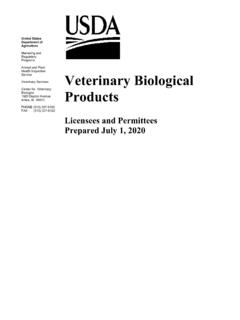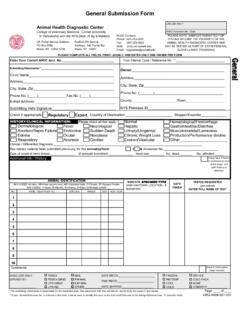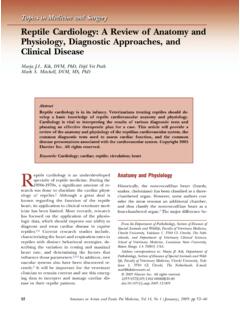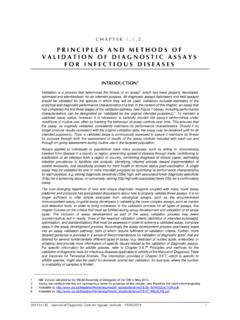Transcription of Manual of Diagnostic Tests and Vaccines for Terrestrial ...
1 Manual of Diagnostic Tests and Vaccines for Terrestrial Animals 2013 Chapter Collection, submission and storage of Diagnostic specimens (NB: Version adopted in May 2013) Chapter Transport of specimens of animal origin (NB: Version adopted in May 2013) Chapter Biosafety and biosecurity in the veterinary Diagnostic microbiology laboratory and animal facilities Chapter Quality management in veterinary testing laboratories (NB: Version adopted in May 2012) Chapter Bovine brucellosis (NB: Version adopted in May 2009) Chapter Caprine and ovine brucellosis (excluding Brucella ovis) (NB: Version adopted in May 2009) Chapter Ovine epididymitis (Brucella ovis) (NB: Version adopted in May 2009) Chapter Porcine brucellosis (NB: Version adopted in May 2009) NB.
2 Version adopted by the World Assembly of Delegates of the OIE in May 2013 OIE Terrestrial Manual 2013 1 SECTION INTRODUCTORY CHAPTERS CHAPTER COLLECTION, SUBMISSION AND STORAGE OF Diagnostic SPECIMENS INTRODUCTION Laboratory investigation of animal disease is critically dependent on the quality and appropriateness of the specimens collected for analysis. This chapter sets out the general standards involved in specimen collection, submission, and storage. The individual disease chapters in this Terrestrial Manual provide specific information on appropriate specimens needed in order to test for particular pathogens or toxins.
3 Sampling may be from individual animals, from animal populations, or from the environment for a variety of purposes, such as disease diagnosis, disease surveillance, health certification, and monitoring of treatment and/or vaccination responses. To provide scientifically and statistically valid results the specimens collected must be appropriate for the intended purpose, and adequate in quality, volume, and number for the proposed testing. Additionally, the animals and tissues sampled must be appropriately representative of the condition being investigated.
4 Specimens must be collected using appropriate biosafety and containment measures in order to prevent contamination of the environment, animal handlers, and individuals doing the sampling as well as to prevent cross-contamination of the specimens themselves. Care should additionally be taken to avoid undue stress or injury to the animal and physical danger to those handling the animal. Biological materials should be packaged to rigorously control for leakage, and then labelled with strict adherence to the applicable regulations guiding their transport as outlined in Chapter A.
5 COLLECTION OF SAMPLES 1. General considerations Careful consideration must be given to the collection, containment, and storage of the specimens, including biosafety measures that must be in place to prevent contamination of the environment or exposure of other animals and humans to potentially infectious materials (see Chapter Standard for Managing Biorisk in veterinary Laboratories). For information on transport of specimens see Chapter Transport of Specimens of Animal Origin. The reliability of the Diagnostic testing is critically dependent on the specimen(s) being appropriate, of high quality, and representative of the disease process being investigated.
6 Prior to sampling, consideration must be given to the type of specimen(s) needed including the purpose of the testing and the test technologies to be used. The volume or quantity of specimen must be sufficient to perform initial testing, to perform any subsequent confirmatory testing and to provide sufficient residual specimen for referral or archival purposes. The purposes of testing will be aligned with the purposes for which Tests are validated, as listed in Chapter Principles and methods of validation of Diagnostic assays for infectious diseases, namely.
7 Chapter Collection and storage of Diagnostic specimens 2 OIE Terrestrial Manual 2013 i) Demonstration of freedom from infection in a defined population. ii) Certification of freedom from infection or presence of the agent in individual animals or their products for trade/movement purposes. iii) Eradication of disease or elimination of infection from defined populations.
8 Iv) Confirmatory diagnosis of suspect or clinical cases. v) Estimation of prevalence of infection or exposure to facilitate risk analysis. vi) Determination of immune status of individual animals or populations (post-vaccination). Epidemiologically appropriate sampling plans should be developed prior to collection of specimens, as described in Section B and Appendix These will specify the number of animals or other sampling units to be sampled. Specimens must be collected according to a sound knowledge of the epidemiology and pathogenesis of the disease under investigation, or the disease syndrome to be diagnosed.
9 This will lead to the sampling of tissues or fluids most likely to contain the infectious agent or evidence of the infection. Considerations will include the tissue predilection(s) or target organ, the duration and site of infection in each tissue type and the duration and route of shedding, or the time frame in which evidence of past infection, such as an antibody response, can be detected reliably by the Tests to be deployed. These considerations will also indicate the method(s) of collection to be used. In many herd or flock-based disease investigations it is beneficial to collect specimens from a healthy cohort for comparative epidemiological or baseline testing ( case-control and cohort approaches for Diagnostic testing) and for validation purposes.
10 Where chemical euthanasia or anaesthesia is required for animal restraint, the impact of the chemical on the test result ( toxicology testing) must be considered. Some laboratory Tests are not compatible with specific blood anticoagulants and tissue preservatives, such as heparin, formalin, dry ice (exposure of the test sample to elevated levels of CO2), or even freezing. While it is critical to collect specimens as aseptically as possible, equal care must be taken to avoid contamination with detergents and antiseptic treatments used to clean the collection site on the animal, as these agents may interfere with the laboratory test procedures.

















